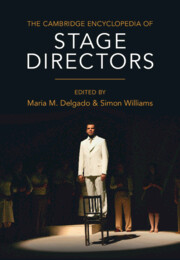Refine search
Actions for selected content:
21 results
Chapter 3 - Symbolism and Expressionism
- from Part I - Forms and Genres
-
-
- Book:
- The Cambridge Companion to Modernist Theatre
- Published online:
- 28 August 2025
- Print publication:
- 11 September 2025, pp 55-71
-
- Chapter
- Export citation
Chapter 6 - Schoenberg the Painter
- from Part II - More than a Composer
-
-
- Book:
- Schoenberg in Context
- Published online:
- 04 September 2025
- Print publication:
- 04 September 2025, pp 51-67
-
- Chapter
- Export citation
Chapter 32 - Poetry, Literature and Language
- from Part VIII - Ideas, Beliefs and Interventions
-
-
- Book:
- Schoenberg in Context
- Published online:
- 04 September 2025
- Print publication:
- 04 September 2025, pp 316-324
-
- Chapter
- Export citation
Chapter 18 - Igor Stravinsky (and Adorno)
- from Part V - Schoenberg’s Others
-
-
- Book:
- Schoenberg in Context
- Published online:
- 04 September 2025
- Print publication:
- 04 September 2025, pp 186-194
-
- Chapter
- Export citation
Chapter 11 - Atonality
- from Part III - Approaches to Composition
-
-
- Book:
- Schoenberg in Context
- Published online:
- 04 September 2025
- Print publication:
- 04 September 2025, pp 108-121
-
- Chapter
- Export citation
Chapter 25 - Theatre
- from Part VI - Viennese Institutions
-
-
- Book:
- Schoenberg in Context
- Published online:
- 04 September 2025
- Print publication:
- 04 September 2025, pp 250-257
-
- Chapter
- Export citation
Chapter 20 - Boulez’s Poets
- from Part IV - Creative Engagements beyond Music
-
-
- Book:
- Boulez in Context
- Published online:
- 08 July 2025
- Print publication:
- 24 July 2025, pp 215-226
-
- Chapter
- Export citation
Chapter 16 - W. B. Yeats
- from Part III - Collaborators and Critics
-
-
- Book:
- Sean O'Casey in Context
- Published online:
- 23 June 2025
- Print publication:
- 10 July 2025, pp 173-181
-
- Chapter
- Export citation

The Cambridge Encyclopedia of Stage Directors
-
- Published online:
- 19 June 2025
- Print publication:
- 03 July 2025
Chapter 5 - Prometheus Found
- from Part II
-
- Book:
- Modernism, Aesthetics and Anthropology
- Published online:
- 09 January 2025
- Print publication:
- 23 January 2025, pp 177-219
-
- Chapter
- Export citation
3 - Bearing Ambiguity
-
- Book:
- The Theological Imagination
- Published online:
- 09 November 2024
- Print publication:
- 07 November 2024, pp 67-104
-
- Chapter
- Export citation
1 - Prelude
-
- Book:
- Schoenberg: ‘Night Music' – <i>Verklärte Nacht and Erwartung</i>
- Published online:
- 30 November 2023
- Print publication:
- 30 November 2023, pp 1-17
-
- Chapter
- Export citation
Chapter 5 - The Apocalypse of Hope
-
- Book:
- German Philosophy and the First World War
- Published online:
- 30 March 2023
- Print publication:
- 20 April 2023, pp 153-185
-
- Chapter
- Export citation
Chapter 3 - Fritz Eichenberg & Charlotte Brontë’s Jane Eyre
-
- Book:
- The Art of the Reprint
- Published online:
- 23 March 2023
- Print publication:
- 30 March 2023, pp 94-123
-
- Chapter
- Export citation
Chapter 6 - Germany and Austria-Hungary
- from Part II - Nations and Voices
-
-
- Book:
- A History of World War One Poetry
- Published online:
- 18 January 2023
- Print publication:
- 12 January 2023, pp 99-117
-
- Chapter
- Export citation
Chapter 1 - Broadway Post-1945 to 1960
- from Part I - Commercial and Mainstream Theatre
-
-
- Book:
- The Cambridge Companion to American Theatre since 1945
- Published online:
- 20 August 2021
- Print publication:
- 09 September 2021, pp 19-44
-
- Chapter
- Export citation
3.1 - Gothic and Silent Cinema
-
-
- Book:
- The Cambridge History of the Gothic
- Published online:
- 29 July 2021
- Print publication:
- 19 August 2021, pp 22-42
-
- Chapter
- Export citation
Chapter 6 - Brecht and Political Theater
- from Part I - Brecht’s World
-
-
- Book:
- Bertolt Brecht in Context
- Published online:
- 28 May 2021
- Print publication:
- 10 June 2021, pp 57-64
-
- Chapter
- Export citation
Chapter 2 - Primitivism, Ethnography and Magical Realism
- from Part I - Origins
-
-
- Book:
- Magical Realism and Literature
- Published online:
- 22 October 2020
- Print publication:
- 12 November 2020, pp 30-48
-
- Chapter
- Export citation
Chapter 21 - Borges and the First Spanish Avant-Garde
- from Part II - The Western Canon, the East, Contexts of Reception
-
-
- Book:
- Jorge Luis Borges in Context
- Published online:
- 16 January 2020
- Print publication:
- 23 January 2020, pp 173-179
-
- Chapter
- Export citation
